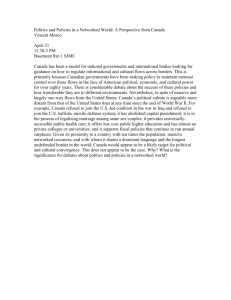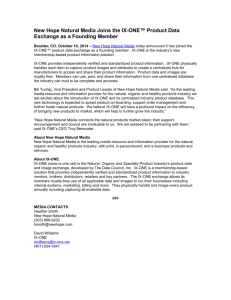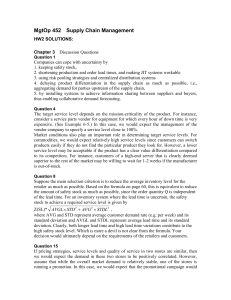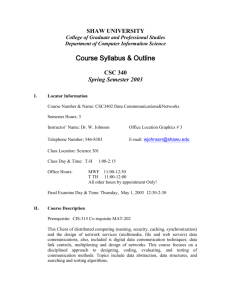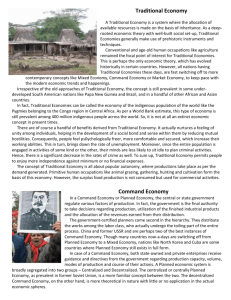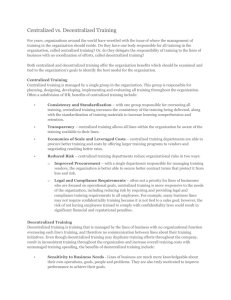c h a p t e r 3 INFORMATION SYSTEMS, ORGANIZATIONS
advertisement
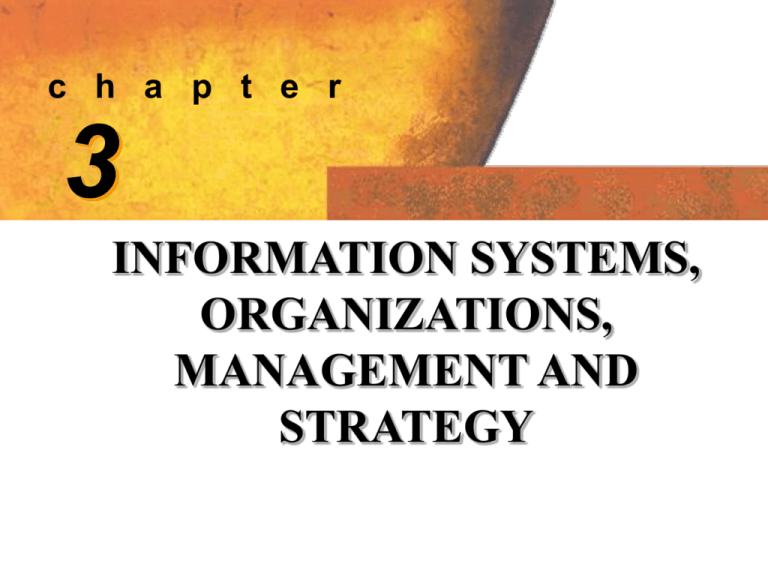
c h a p t e r 3 INFORMATION SYSTEMS, ORGANIZATIONS, MANAGEMENT AND STRATEGY What is an organization? (1) • Technical definition • A stable, formal, social structure • Takes resources from environment, processes them and produces outputs What is an organization? (2) • Behavioural Definition – A collection of rights, privileges, obligations, responsibilities – Delicately balanced through conflict and conflict resolution Environmental resources Environmental outputs Common Structural Features of Organizations • • • • • • Clear division of labour Hierarchy Explicit rules and procedures Impartial judgment Technical qualifications for positions Maximum organizational efficiency Additional Common Features of Organizations • Standard Operating Procedures (SOPs) • Organizational Politics • Organizational Culture Unique Features of Organizations • Different organizational types • Organizations and environments • Other differences •Goals •Leadership •Power •Tasks •Constituencies •Technology •Function •Business processes Five Basic Kinds of Organizations • Entrepreneurial: Young, small, fast-changing • Machine bureaucracy: large, slowchanging, centralized • Divisionalized bureaucracy: combination of machine bureaucracies, one central headquarters • Professional bureaucracy:knowledgebased, weak centralized authority • Adhocracy: large groups of specialists, teams, task-forces Delivery of IT Services • The information systems department – PROGRAMMERS: Write software – SYSTEMS ANALYSTS: Translate business problems into solutions – IS MANAGERS: Department & team leaders – END USERS: Department reps for whom applications are developed – CHIEF INFORMATION OFFICER (CIO): senior manager of IS department How IS Affect Organizations: Economic Theories • Microeconomic model • IT can be substituted for capital and labour • IT should result in fewer middle managers • Transaction cost theory • IT should reduce transaction costs • IT should help firms constrict in size • Agency theory • IT can reduce costs of acquiring information • Managers can oversee more employees, reduce management costs Transaction Cost Theory Agency Cost Theory How IS Affect Organizations: Behavioural Theories • IT can affect hierarchy of decision-making – Lower costs of obtaining information – Allow broader distribution of information – Reduce need for middle management & clerical support, allow flattening of organization Implementing Change Changes in IT are absorbed, deflected, and defeated by task arrangements, structures and people Source: Leavitt, 1965 The Internet and Organizations • Impacts relationship between firms and external entities • Impacts internal business processes • Can lower transaction and agency costs Implications for IS Design and Understanding • Environment • Org. structure • Org. culture and politics • Type of organization • Leadership style • Top management’s understanding of IS • Principal interest groups affected by IS • Kinds of tasks, decisions & processes • Attitudes of workers • History of IS in the organization: existing skills, human resources Managers, Decision-Making & Information Systems Two models of managerial role • CLASSICAL: – Describe functions -- plan, organize, coordinate, decide, control • BEHAVIORAL: – Based on observations of managers on the job – Managers are more informal, less reflective, more reactive, less organized than expected Three Managerial Activities • Managers spend time establishing personal agendas, long- and short-term goals • Managers spend time building an interpersonal network • Managers use their personal network to execute personal agendas to accomplish their own goals Managerial Roles • Interpersonal – Act as figureheads, leaders, and liaisons • Informational – Act as nerve centres, disseminator and spokespersons • Decisional – Act as entrepreneurs, disturbance handlers, resource allocators Managers and Decision-Making ORGANIZATIONAL LEVEL TYPE OF DECISION STRUCTURED OPERATIONAL KNOWLEDGE STRATEGIC ACCOUNTS RECEIVABLE TPS ELECTRONIC SCHEDULING OAS SEMISTRUCTURED PRODUCTION COST OVERRUNS MIS BUDGET PREPARATION PROJECT SCHEDULING DSS KWS UNSTRUCTURED MANAGEMENT PRODUCT DESIGN FACILITY LOCATION ESS NEW PRODUCTS NEW MARKETS Stages of Decision-Making INTELLIGENCE: Collect information; identify problem DESIGN: Conceive alternatives; select criteria CHOICE: Use criteria to evaluate alternatives; select IMPLEMENTATION: Put decision into effect; allocate resources; control Individual Models of DecisionMaking • Rational – Comprehensive rationality; evaluate all alternatives • Systematic – Structured, formal method • Intuitive – Trial & error, unstructured, multiple approach Organizational Models of Decision-Making • Bureaucratic – Follow standard operating procedures (SOP) • Political – Key groups compete and bargain • “Garbage can” – Organizations not rational; solutions accidental Strategic Information Systems • Change the goals, products, operations, services or environmental relationship of organizations • Help organization achieve competitive advantage – Being ahead of the competition by cost/price, market share, etc. Value Chain Model • Highlights primary or support activities where information systems can best be applied to achieve a competitive advantage • E.g. Inbound logistics, sales and marketing, customer services Role of IT at Business Level • Reduce costs • Differentiate product – Create loyalty by developing new and unique products/services, not easily duplicated • Serve new markets – Focus on a market niche Lock In Customers & Suppliers • SUPPLY CHAIN MANAGEMENT – Stockless inventories, continuous replenishment, just-in-time delivery • INTRA FIRM STRATEGY – Product differentiation, focused differentiation, low-cost producer • EFFICIENT CUSTOMER RESPONSE – Point-of-sale systems, datamining Industry-Level Strategy and IT • Information Partnerships – Air Canada and credit card companies have arrangements to award frequent-flyer points • Competitive Forces Model • Network Economics Network Economics • New model of competitive forces • Internet builds communities of users • The marginal costs of adding another participant are negligible while the marginal gain is much larger Management Issues • Managing strategic transitions • Sustaining competitive advantages International Information Systems General Cultural Factor Specific Business Factor Global communication and transportation technologies Global markets Development of global culture Global production and operations Emergence of global social and educational norms Global coordination Political stability or instability Global workforce Global knowledge base Global economies of scale Organizing International IS • • • • Domestic exporter Multinational Franchiser Transnational Global Strategy Business Function Domestic Exporter Multinational Franchiser Transnational Production Centralized Decentralized Networked Networked Finance/ Accounting Centralized Centralized Centralized Networked Sales/ Marketing Mixed Decentralized Networked Networked Human Relations Centralized Centralized Networked Networked Strategic Management Centralized Decentralized Centralized Networked
